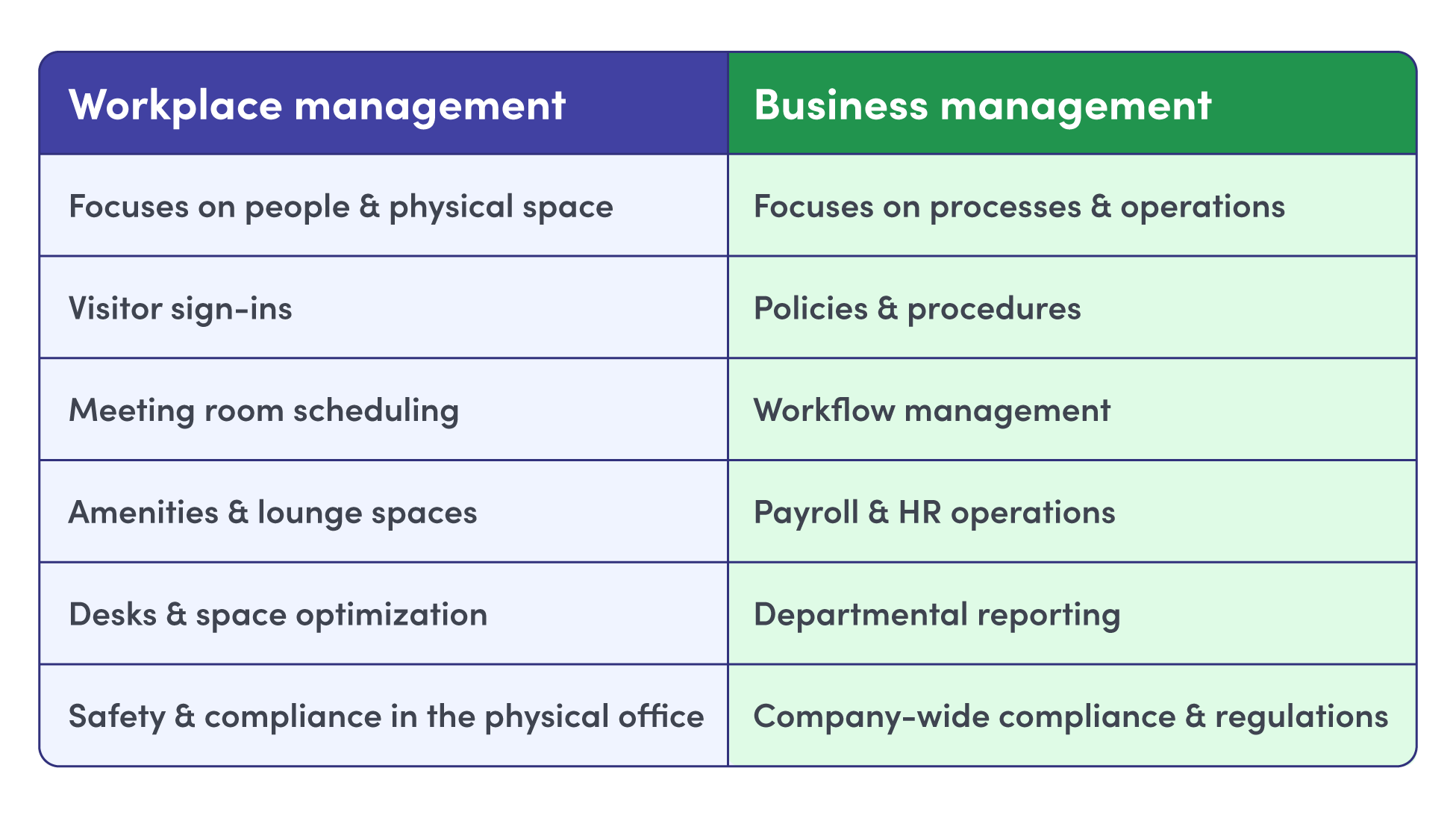Ever had a day where a visitor showed up early, a meeting room was double‑booked, and the Wi‑Fi went down—all before lunch? That’s exactly what effective workplace management helps prevent. It’s the system that keeps everything from security and compliance tasks to space planning and employee experience in sync. When the right tools, processes, and safeguards come together, your workplace becomes a space people trust, enjoy, and actually want to use.
In this post, we’ll explore workplace management as a system that keeps your space running smoothly and your employees happy. We’ll cover:
- What is workplace management?
- Who needs workplace management?
- 5 benefits of workplace management
- Workplace management best practices
What is workplace management, exactly?
Workplace management covers everything from visitor check-ins and room booking systems to space layout, tech integration, and culture building—components of a well-functioning space. It also includes security and compliance measures like visitor screening, access control, and adherence to safety or regulatory requirements.
When all these pieces align, your operations run smoothly, risks remain low, and employees stay engaged.
Why should I care about workplace management today?
Hybrid work has made the workplace more complex than ever. Attendance, desk usage, and visitor flow are just a few of the moving parts to manage. At the same time, compliance requirements are tightening, raising the stakes for any security lapse.
To get employees back onsite, you need to optimize your space to deliver value. That starts with making the office worth their commute. Recent Envoy data shows that office attendance is climbing in major city centers, with collaboration-heavy industries leading the charge—proof that well-run workplaces draw people in.
All these factors make workplace management essential today. It’s what makes your office efficient, secure, and a place people want to work.
What’s the difference between business management and workplace management?
The difference comes down to focus. Workplace management is about the people and spaces in your office, while business management is about the processes and operations that keep the company running.

{{protip-1}}
Who needs workplace management?
Any organization with a physical workspace—whether it’s a single floor or multiple global locations—needs workplace management.
Without workplace management, things break down fast: visitors show up unannounced, employees waste time hunting for a place to meet, and no one knows what to do during an emergency. The result? Frustrated teams, lower productivity, and unnecessary risk.
With the right tools in place, the same workplace becomes a well‑run operation. Guests check in securely, employees can find a desk or room in seconds, and everyone knows how to respond when it matters most.
5 ways workplace management transforms your space
An effective workplace management strategy keeps your space ticking along, without any dips in productivity or employee experience. Let’s look at five of the top benefits and what they actually look like day to day.
1. Strengthens security and compliance
Workplace management protects your people, assets, and organization. It includes visitor management, different security policies, and emergency response procedures that help reduce risk to your employees, facilities, and assets.
An effective workplace management strategy transforms your space by turning security from a static system into a dynamic safeguard. It ensures tools like surveillance, alarms, access controls, and ID verification are not just present, but optimized to proactively keep your space—and everything in it—safe and secure.
{{protip-2}}
2. Maximizes the space you already have
Office space is expensive, and underused areas can quietly drain your budget. A recent report shows that office vacancy in the U.S. reached nearly 20% by the end of 2024—meaning one in five square feet was sitting empty—so optimizing your footprint isn’t just smart, it’s critical.
Workplace management helps you understand how employees actually use the space. With data from sensors, room bookings, and traffic patterns, you can spot underutilized zones and rework layouts to better support collaboration, focus, or social interaction—improving functionality without adding square footage.
{{protip-3}}
3. Keeps your workplace flexible and future‑ready
Today’s workplaces need to handle constant change—hybrid schedules, growing teams, or evolving business strategies. Workplace management supports flexible work models with tools like desk booking software, meeting room scheduling, and interactive workplace maps.
These tools let employees work where and how they’re most effective, while giving leadership a clear view of capacity and usage.
{{protip-4}}
4. Boosts employee productivity and morale
When the workplace works well, employees actually feel it. Comfortable, well-designed spaces that are easy to navigate cut down on daily annoyances and distractions, helping people get into their flow faster. Having access to the space they need to be productive and build connections while onsite supports productivity and helps build stronger teams.
Reliable tech that just works—no delays, no headaches—lets employees focus on their tasks instead of troubleshooting. All these factors come together to create a workplace that people want to show up for, boosting both productivity and loyalty over time.
{{protip-5}}
5. Reduces costs and prevents waste
Running a workplace comes with countless hidden costs—empty meeting rooms that eat up rent, forgotten tech that collects dust, or maintenance that only happens once something breaks. Workplace management brings visibility to these inefficiencies so you can spend intentionally and cut out waste.
From automating preventive maintenance to rightsizing furniture orders and streamlining vendor contracts, workplace leaders can lower overhead and avoid unnecessary purchases. The result? A leaner operation that saves money and supports growth.
{{protip-6}}
Workplace management best practices that actually work
Building a strong workplace management strategy doesn’t happen overnight. You have to take practical steps that fit your unique organization. Here are some best practices to follow.
Spot and solve your biggest pain points first
Start by taking a hard look at how your workplace functions today. Where are employees getting frustrated, and where is the space underperforming?
For example, you might notice employees pacing the halls to find a private spot for a call, or large conference rooms sitting empty most of the week. These observations reveal gaps you can address quickly—whether that’s adding small focus rooms, reconfiguring seating, or improving the way people book spaces. Tackling the most obvious pain points first builds momentum for your strategy.
Get direct feedback from your employees
The best workplace management strategies are employee‑driven. Your people know what’s working and what’s not, so ask them. Surveys and quick interviews can uncover issues you might miss on your own.
Helpful questions include:
- What makes you want to work onsite instead of from home?
- Which spaces do you use most—and least?
- What tools or amenities would make you more productive onsite?
Collecting this feedback not only guides better decisions but also signals to employees that their experience matters.
Use technology and automation to stay ahead
Modern workplaces run on technology. If your tools don’t integrate, or if processes are manual and clunky, employees notice. A strong workplace management strategy includes regular reviews of your tech stack and looks for ways to automate repetitive tasks.
For example, a workplace platform can bring together room and desk booking, visitor check‑ins, access control, and maintenance requests in one place. Automation can handle routine tasks—like triggering a cleaning request after a room is vacated—so your team can focus on higher‑impact work.
Plan for growth and change, not just today
Workplaces evolve fast. A team that fits comfortably now might outgrow the space in a year—or you might shift to more hybrid work and need less space altogether. Building a flexible, future‑focused workplace management strategy means considering:
- How your headcount might grow or shrink
- How hybrid or remote policies could change
- Which tools can scale with your business without disruption
Being proactive means your workplace adapts to change seamlessly.
–
Workplace management isn’t a one-time project—it’s an ongoing process. Done well, it turns your office into a space that’s safe, efficient, and enjoyable to work in. Wondering how to put these ideas into action?
Check out our ultimate guide library, a go-to resource that covers everything on how to better manage your workplace.
Quick takeaway: Business management runs the company. Workplace management runs the space.
How it looks in action: With real-time visibility into who’s in the building and automated recordkeeping, a company stays audit-ready while responding fast and confidently in a crisis.
How it looks in action: Say desk sensors show that 30% of assigned workstations are empty on an average Tuesday. The workplace team might convert some of those into shared collaboration spaces or reduce their footprint to save on rent.
How it looks in action: When a regional sales team visits HQ, the workplace platform the company uses to manage its space sends mobile access passes to their phones and updates desk and room availability in real time—letting them settle in quickly without interrupting the daily flow for regular staff.
How it looks in action: Employees can easily grab a quiet room for a client call, get the presentation gear they need without waiting on IT, and hang out in a lounge for a quick team brainstorm—all without any hassle or wasted time.
How it looks in action: A usage report shows that a 12-person conference room is rarely full. The facilities team converts it into smaller huddle rooms, avoiding extra leases and cutting electricity and cleaning costs for an underused space.
Read more
Searching for a visitor management solution? Learn what to look out for and how to choose the best tech for your team.
Managing your space well doesn’t have to be difficult. But if you want to be successful, you need the right approach.
A well-run workplace can set your team up for success. Learn why workplace management matters and how to do it right.
Workplace security is critical to the future of your business. Learn why it matters, what threats to watch for, and how to strengthen your workplace security plan.
In this post, we’ll explore what workplace compliance is and how to build a compliance culture for your organization.
With more folks sending personal packages to the workplace, having a sound mailroom management system in place is key.










